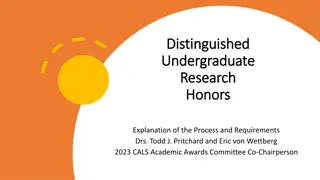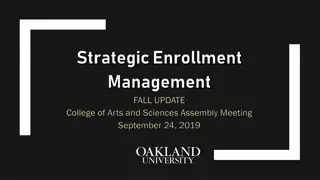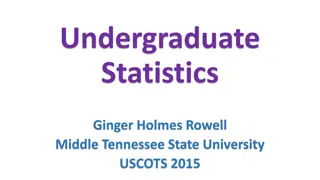The New Undergraduate Experience
This content highlights the imperative for racial equity and justice in public higher education through the lens of the New Undergraduate Experience (NUE) report. It emphasizes the need for structural changes to support diversity, social mobility, and economic impact. Addressing historic systemic racism, the report discusses challenges in retaining Black and Latinx students and achieving equitable graduation rates, despite controlling for socioeconomic status.
Download Presentation

Please find below an Image/Link to download the presentation.
The content on the website is provided AS IS for your information and personal use only. It may not be sold, licensed, or shared on other websites without obtaining consent from the author.If you encounter any issues during the download, it is possible that the publisher has removed the file from their server.
You are allowed to download the files provided on this website for personal or commercial use, subject to the condition that they are used lawfully. All files are the property of their respective owners.
The content on the website is provided AS IS for your information and personal use only. It may not be sold, licensed, or shared on other websites without obtaining consent from the author.
E N D
Presentation Transcript
The New Undergraduate Experience (NUE) Amcoa Team Meeting March 11, 2022
Equity Agenda New Undergraduate Experience The New Undergraduate Experience (NUE) report is a declaration meant to clearly express a new vision for the cultural, curricular, pedagogical, and structural changes needed for a public higher education transformation focused on racial equity and justice. There are three reasons this work is important: 1 2 3 Moral Democratic Economic Like most higher education systems across the country, the Massachusetts system was built on centuries of racism and white privilege that preference young, economically privileged, native-born white men. The Commonwealth s system needs to evolve to support today s diverse students. The Massachusetts public education system has the responsibility to create opportunities for social mobility and to educate the Commonwealth s residents to enhance engagement in social and political systems. Data show that Massachusetts Black and Latinx students are more likely to be in the lowest income group with the lowest expected family contribution. If these trends continue as the Commonwealth s population becomes more diverse, there may be a negative impacts to the economy. 2
Development of the Strategic Plan for Racial Equity The New Undergraduate Experience (NUE) report is a visioning document for the 10-year statewide strategic plan focused on racial equity. It is one of several inputs that will influence the development of the strategic plan: Environmental Scan Stakeholder Input via Strategy Labs & Review Sessions System-Wide Data Analysis System-Wide Survey Stakeholder Interviews and Focus Groups Leading Best Practices NUE Report Statewide Strategic Plan for Racial Equity 3
Gaps Begin Early The institutional equity gap begins early. Community colleges and UMass and state universities retain Black and Latinx students after completing their first year of study at lower rates than the overall student population. 4
Graduation Rates The system graduates the overall student population who begin their undergraduate journey at UMass and state universities at higher rates than Black and Latinx students. 5
Socioeconomic Status Moreover, controlled for socioeconomic status, Black and Latinx students still have inequitable access to and outcomes in Massachusetts public higher education.
Introduction We argue that the cause of these discrepancies is historic and systemic racism that has long shaped the higher education system and limited access to education, generational wealth, and social mobility to a select few. Moreover, creating a more equitable higher education system will not only improve the system for racially minoritized students*, but will improve offerings and outcomes for all the Commonwealth s students, including all racially minoritized groups and White students and with consideration for intersectional identities. *Throughout this report, the term racially minoritized students is used to refer to Black and Latinx students who are the focus of this report. NUE authors chose this terminology based on the most recent language being used by the Massachusetts Department of Education. NUE authors believe this terminology to be the most representative at this time but understand that language and terminology evolve and, therefore, racially minoritized students may not resonate with all constituencies and may evolve over time.
Committees and Structure Steering Committee Teaching and Learning Committee Student-Ready Institutions Committee Faculty, Curriculum and Pedagogy Professional Development and Assessment Holistic Student Supports Foundational Elements Institutional Culture Transitions 8
Student Bill of Rights NUE s recommendations align with the below Student Bill of Rights. To fulfill these, the Massachusetts public higher education system must focus on racial equity and justice. 1. Clear, accessible, and understandable financial information, and affordable and predictable education costs 2. Inclusive, anti-racist, and culturally responsive curricula and pedagogies 3. Equitable access to experiential learning opportunities, in and out of the classroom Students Have the Right to: 4. Diverse and supportive faculty and staff who are equity- minded higher education practitioners 5. Welcoming, inclusive, and safe campus environments 6. Timely and relevant pathways to graduation and employment 7. A voice in the decisions that affect their education 9
Content-Specific Recommendations NUE s content-specific recommendations are organized by the following categories which are aligned to the Student Bill of Rights. The rest of the presentation takes a deep dive into these categories. Category Students have the right to clear, accessible, and understandable financial information, as well as affordable and predictable education costs Inclusive, anti-racist, and culturally responsive curricula and pedagogies Equity-Minded Teaching, Learning, and Assessment and pedagogies High-Impact Practices and the Co-Curriculum the classroom Diverse and supportive faculty and staff who are equity- minded higher education practitioners Student Bill of Rights Admissions, Enrollment, and Transfer 1. 2. The Curriculum Inclusive, anti-racist, and culturally responsive curricula 3. Equitable access to experiential learning opportunities, in and out of 4. Hiring, Supporting, and Retaining Faculty of Color 5. Welcoming, inclusive, and safe campus environments and timely and relevant pathways to graduation and employment A voice in the decisions that impact their undergraduate experience 6. 7. Holistic Student Support Student Voice 10
Content-Specific Recommendations 11
Admissions, Enrollment and Transfer The recommendations in Admissions, Enrollment, and Transfer, focus on eliminating barriers in the application and enrollment processes and on creating clear and seamless transfer pathways. This will provide a more equitable structure and support system that will ensure more racially minoritized students have access to the Massachusetts public higher education system. #1: Students have a right to clear, accessible, and understandable financial information, as well as affordable, and predictable education costs. 12
Admissions & Enrollment Recommendations (1 of 2) Examine admissions practices through a racial equity and justice lens to ensure that all students feel supported in the application and enrollment processes. 1 Develop and implement recruitment, admissions, and enrollment policies and practices that increase the enrollment of racially minoritized students. 2 Establish practices that support students in understanding and accessing financial aid. 3 Develop admissions policies that automatically welcome and accept all high school seniors who live within a regional catchment area to attend their institution, without students needing to go through any application process because racially minoritized students are often undermatched and are not always encouraged to apply to universities. This approach must be piloted, and data-gathering to support it must be scaled up. 4 Recommended Owners 13 = Individual Institutions = DHE/Institution Collaboration = DHE/BHE Led
Admissions & Enrollment Recommendations (2 of 2) Partner with community-based organizations that provide counseling and services to college applicants of all ages. 5 Work with high schools across the Commonwealth to establish quality Early College programming through its public institutions and increase enrollment in designated Early College programs. 6 Establish Early College funding models that are flexible and inclusive including art and design pathways. 7 Create programs to ensure that every Early College student in the Commonwealth is automatically accepted to their local community college or state university without needing to submit SAT scores or complete enrollment paperwork. 8 Recommended Owners 14 = Individual Institutions = DHE/Institution Collaboration = DHE/BHE Led
Transfer Recommendations Develop a statewide dual admissions program between community colleges and universities to reduce the uncertainty and barriers of transfer that disproportionately affect racially minoritized students. 1 Require institutions to use the MassTransfer course-equivalency database to facilitate the smooth transfer of courses. 2 Develop a system that will automatically contact qualifying transfer students to complete the Reverse Transfer/FERPA release form when eligible for an associate s degree . 3 Recommended Owners 15 = Individual Institutions = DHE/Institution Collaboration = DHE/BHE Led
The Curriculum Overview The recommendations in this section are targeted at the first semesters of the undergraduate experience, ensuring an asset-based and equity- minded approach. They address a vision of a rejuvenated Core framework and the need for racial justice education within that framework. #2: Students have a right to inclusive, anti-racist , and culturally responsive curricula and pedagogies. 16
Credit for Prior Learning/Prior Learning Assessment Recommendations Strengthen Prior Learning Assessment (PLA or CPL) consortium by including universities. 1 Create transfer policy and partnership among all universities to recognize CPL awarded by community colleges. 2 Ensure equity-minded oversight of CPL, including the creation of equity-minded assessments and reviews of practices to ensure that racially minoritized students are benefitting from CPL. 3 Recommended Owners 17 = Individual Institutions = DHE/Institution Collaboration = DHE/BHE Led
English Language Learners Recommendations Formalize a DHE-supported, statewide working group to create integrated courses, share resources and best practices, standardize system and design, recommend non-credit to credit pathways, and create a rubric for awarding credit to multilingual students. 1 Collect comprehensive and intersectional data on post-secondary ELL beyond enrollment: age, full- or part-time status, demographics across the state, retention, completion, transfer, and employment. 2 Provide more ELL resources to community colleges through existing budget streams. 3 Adopt the Seal of Biliteracy to provide credit to multilingual students in order to receive credit, similar to Advanced Placement scores. 4 Recommended Owners 18 = Individual Institutions = DHE/Institution Collaboration = DHE/BHE Led
Developmental Education Recommendations Redirect financial resources to support students in developmental education, through existing budget streams such as HEIF grants and institutional aid. 1 Align college curricula with feeder high school content in partnership with the Department of Elementary and Secondary Education to ensure that students do not repeat and pay for courses unnecessarily. 2 Revive the statewide Developmental Education Advisory Board and charge it with phasing out noncredit-bearing standalone developmental education courses systemwide and supporting community colleges and universities in developing credit-bearing courses designed to support students in their learning, including co- requisite, integrated, and accelerated options, in alignment with NECHE accreditation standards. 3 Recommended Owners 19 = Individual Institutions = DHE/Institution Collaboration = DHE/BHE Led
Rejuvenated Core Curriculum Recommendations Create and charge a broadly inclusive working group with the examination and re-design of the core curriculum while maintaining the benefits of the MassTransfer General Education Foundation. 1 Create a Core Curriculum framework that is outcomes-driven rather than content-driven while still allowing for individual institutional flexibility. 2 Integrate racial justice education principles into the core curriculum framework. 3 Integrate racial justice learning outcomes throughout the curriculum and co-curriculum, woven into each institution s mission and mapped onto disciplinary and institutional learning outcomes. 4 Recommended Owners 20 = Individual Institutions = DHE/Institution Collaboration = DHE/BHE Led
Majors, Minors, and Certificate Programs Recommendations Create interdisciplinary programs to develop students abilities to address complex public and societal problems. 1 Guide students into exploring the public dimensions of their field of study, including how the field can contribute to understanding and addressing major public problems such as racism, especially the general studies area of study. 2 Provide faculty in every program of study with student success data disaggregated by race that will enable them to analyze the points at which the institution is failing to serve racially minoritized students in their program and explore alternative practices that would better serve these students. 3 When developing new programs or making changes to existing programs, ensure the design includes recruitment and marketing strategies; enrollment and retention; learning goals and objectives; and faculty, staff, and operational resource allocation, which are deliberate and intentional in serving racially minoritized students. Recommended Owners 4 21 = Individual Institutions = DHE/Institution Collaboration = DHE/BHE Led
Equity-Minded Teaching, Learning, and Assessment Overview The recommendations in Equity- Minded Teaching, Learning, and Assessment section, focus on creating a more inclusive, anti-racist teaching and learning atmosphere at Massachusetts public higher education institutions. #2: Students have a right to inclusive, anti-racist , and culturally responsive curricula and pedagogies. 22
Equitable Pedagogical Practices Recommendations Develop and adopt campus-specific, data-driven equity-minded pedagogical approaches. 1 Prioritize trauma training and education, as well as universal design for assignments and curriculum, in strategic planning for Massachusetts colleges and universities. 2 Collect, analyze, and utilize data that portray the benefits of utilizing OER specifically for racially minoritized students. 3 Seek legislative support to obtain funding to create a competitive OER campus funds program to increase and encourage adoption (faculty members enacting OER), adaptation (faculty members remixing and revising existing OER to make it more culturally and disciplinary relevant), and creation (faculty members creating their own digital textbooks for their own and others use) of OER, especially in STEM and core curriculum courses. 4 Implement recognition, financial and nonfinancial incentives, and faculty tenure and promotion to encourage the use and development of OER, community-engaged scholarship, and interdisciplinary pedagogies. Recommended Owners 5 23 = Individual Institutions = DHE/Institution Collaboration = DHE/BHE Led
Equity-Minded Faculty and Staff Development Recommendations Incorporate short-term and long-term equity-focused professional development plans for faculty in institutional strategic plans. 1 Provide faculty with the support and resources necessary for their development in anti-racist and high-impact practices and pedagogies, including the use and interpretation of data. 2 Create and support Centers for Teaching and Learning that can facilitate campus-based and collaborative professional development. 3 Enhance and scale up DHE-supported, systemwide platforms for collaborative professional development. 4 Recommended Owners 24 = Individual Institutions = DHE/Institution Collaboration = DHE/BHE Led
Equity-Minded Assessment Recommendations Create institutional commitment to resources for equity-minded assessment, including support and professional development for faculty-led learning outcomes assessment, and resources for Institutional Research Offices. 1 Implement equity-minded assessment resources including support and professional development for faculty-led learning outcomes assessment, and resources for Institutional Research Offices. 2 Develop institutional learning outcomes and assessment methodologies based on current, equity-minded learning models, such as using authentic student artifacts as the primary source of learning assessment. 3 Provide training and support for faculty and staff on how to conduct institutional assessment and how to conduct data analysis including disaggregating the data in order to assess the impact on racially minoritized students. 4 Recommended Owners 25 = Individual Institutions = DHE/Institution Collaboration = DHE/BHE Led
High Impact Practices and the Co- Curriculum Overview The recommendations in the High Impact Practices (HIPs) and the Co- Curriculum section focus on creating meaningful experiences alongside and outside of the classroom experience. These experiences have been widely tested and shown to be beneficial for college students from many demographic groups. #3: Students have a right to equitable access to experiential learning opportunities, in an out of the classroom. 26
Mentoring Racially Minoritized Students Recommendation Create mentoring networks of racially minoritized faculty, staff, alumni, and employers who will support racially minoritized students throughout their time in the public higher education system. 1 Support faculty who choose to mentor by providing the appropriate training, course release or stipends, and having this work explicitly counted in consideration for promotion, tenure, and merit pay. 2 Recommended Owners 27 = Individual Institutions = DHE/Institution Collaboration = DHE/BHE Led
Equitable Access to Co-curricular and High- Impact Experiences Recommendations (1 of 2) Create a system-wide community of practice in which campuses, employers, and community leaders are engaged in developing shared language, definitions, essential elements, and learning objectives for HIPs and the co-curriculum. 1 Re-envision faculty and staff workloads to allow for effective implementation of HIPs. 2 Establish innovative experiential learning opportunities that count toward degree completion, including rethinking the separation between internship and work . 3 Create anti-racist civic engagement opportunities for students across both the core curriculum and degree programs. 4 Recommended Owners 28 = Individual Institutions = DHE/Institution Collaboration = DHE/BHE Led
Equitable Access to Co-curricular and High- Impact Experiences Recommendations (2 of 2) Institute capstones and learning communities at all community colleges and build on existing ones at universities. 5 Develop opportunities that connect faculty, staff, employers, and students to partner with each other and the DHE in collaborative cross- campus projects. 6 Assess existing honors programs to identify opportunities to improve recruitment of, access for, and support of racially minoritized students. 7 Identify institutional barriers to accessing HIPs for racially minoritized students, assess the impact of these barriers on the students, and remedy the barriers. 8 Recommended Owners 29 = Individual Institutions = DHE/Institution Collaboration = DHE/BHE Led
Hiring, Supporting, and Retaining Faculty of Color Overview Faculty diversity at Massachusetts public higher education institutions does not reflect the diversity of the student body nor the diversity of the state. In order to achieve a more diverse faculty, institutions must create cultures that support faculty of color and that recognize and reward invisible labor that faculty of color take on. The recommendations in this section focus on hiring, supporting, and retaining faculty of color. #4: Students have the right to diverse and supportive faculty and staff who are equity- minded educational practitioners. 30
Hiring Faculty of Color Recommendations Hire Chief Diversity Officers who are empowered to lead diverse faculty hiring and retention efforts to signal institutional commitment to faculty diversity. 1 Develop and implement strategic recruiting plans (including faculty and their spouses) for attracting faculty of color that engage the entire institutional community. 2 Institute a DHE-supported, system-wide effort to develop racially minoritized students to become the faculty of the future. 3 Recommended Owners 31 = Individual Institutions = DHE/Institution Collaboration = DHE/BHE Led
Supporting and Retaining Faculty of Color Recommendations Design and implement promotion, tenure, reward, and recognition processes that prioritize racial equity, justice, equity-mindedness, and more diverse forms of scholarship. 1 Establish employee resources for faculty and staff of color and their allies to cultivate a support community. 2 Develop systems to recognize and reward invisible labor taken on by faculty of color. 3 Recommended Owners 32 = Individual Institutions = DHE/Institution Collaboration = DHE/BHE Led
Holistic Student Support Overview Holistic Student Support is focused on student support across the curricular and co-curricular aspects of their educational experience, ensuring an asset-based approach to supporting racially minoritized students intellectually, emotionally, socially, and physically. Many of the recommendations of this section intersect with existing Department of Higher Education initiatives. NUE s recommendations are meant to affirm and support this ongoing work. #5: Students have the right to welcoming, inclusive, and safe campus environments. #6: Students have the right to timely and relevant pathways to graduation and employment. 33
Academic and Financial Policies Recommendations Examine campus and system discipline, financial, probation, leave (including medical leave), withdrawal, and readmissions policies through an equity lens. 1 Develop and align equitable Satisfactory Academic Progress (SAP) standards, leave, withdrawal and readmissions policies across the Commonwealth, including Fresh Start policies. 2 Implement flexible, accelerated semesters and scheduling so that students who stop out have multiple on-ramps back into learning. 3 Recommended Owners 34 = Individual Institutions = DHE/Institution Collaboration = DHE/BHE Led
Curricular and Co-Curricular Advising and Support Recommendations Create visible networks of faculty and staff who are first-generation and/or people of color, such as campus wide affinity groups or multicultural centers. 1 Reframe support centers as success and achievement centers, or even as Centers of Excellence, moving away from a deficit-minded approach and toward asset-based approaches grounded in recognition of student cultural wealth, offering growth mindset, success strategies, and higher education navigation. 2 Build partnerships between career services and academic departments and programs in creating integrated curricular and co-curricular pathways through graduation and employment. 3 Recommended Owners 35 = Individual Institutions = DHE/Institution Collaboration = DHE/BHE Led
Basic Needs Support Recommendation Implement the recommendations presented in the Basic Needs Security Strategic Plan. 1 Recommended Owners 36 = Individual Institutions = DHE/Institution Collaboration = DHE/BHE Led
Wellness, Conduct, and Safety Recommendations Provide all staff with professional development opportunities on culturally responsive and trauma-informed practices. 1 Diversify our counseling corps and ensure that an understanding of racial trauma is a central part of counseling. 2 Review and revise campus policing practices to address racial trauma, center wellness and mental health awareness, incorporate restorative justice practices, and commit to transparency and accountability. 3 Perform equity-informed assessment of all conduct and discipline policies and practices in order to identify the disproportionate effects on racially minoritized students. 4 5 6 Replace punitive measures with restorative, developmental and educational approaches. Partner with community agencies and other providers to amplify mental health support designed for racially minoritized students. Recommended Owners 37 = Individual Institutions = DHE/Institution Collaboration = DHE/BHE Led
Invitation CALLS TO ACTION: Student voices particularly racially minoritized students voices must continue to be an integral part of the process. #7: Students have a right to a voice in the decisions that impact their education The Board of Higher Education must champion the NUE s recommendations by acting on those the BHE can control and advocating for others. This process must be iterative, collaborative, inclusive, and a constant focus of the BHE, DHE, and individual institutions. 38























